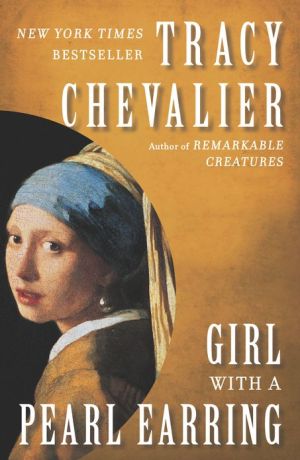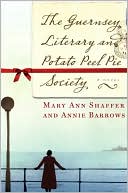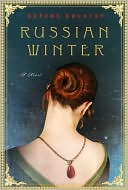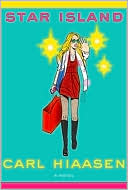Girl with a Pearl Earring
The New York Times bestselling novel by the author of Remarkable Creatures and The Last Runaway\ Translated into thirty-nine languages and made into an Oscar-nominated film, starring Scarlett Johanson and Colin Firth\ Tracy Chevalier transports readers to a bygone time and place in this richly-imagined portrait of the young woman who inspired one of Vermeer's most celebrated paintings.\ History and fiction merge seamlessly in this luminous novel about artistic vision and sensual awakening....
Search in google:
A Deluxe Edition of the National Bestseller with Over 2 Million Copies Sold: • Eight Pages of Full-Color Plates Include Every Vermeer Painting Discussed in the Book • French Flaps • Rough Front • Larger Trim Size • Premium Stock • With a New Foreword Celebrate Tracy Chevalier's modern classic Girl With A Pearl Earring, featuring a gorgeous new edition illustrated with eight pages of Vermeer's masterworks. History and fiction merge seamlessly in this luminous novel about artistic vision and sensual awakening. The story of Griet, whose life is transformed by her brief encounter with a genius as she herself is immortalized in canvas and oil, is new again.New York Times Book ReviewChevalier's exploration into the soul of this complex but naïve young woman is moving, and her depiction of 17th-century Delft is marvelously evocative.
In the morning he asked me to come up in the afternoon. I assumed he wanted me to work with the colors, that he was starting the concert painting. When I got to the studio he was not there. I went straight to the attic. The grinding table was clear—nothing had been laid out for me. I climbed back down the ladder, feeling foolish.\ He had come in and was standing in the studio, looking out a window.\ 'Take a seat, please, Griet,' he said, his back to me.\ I sat in the chair by the harpsichord. I did not touch it—I had never touched an instrument except to clean it. As I waited I studied the paintings he had hung on the back wall that would form part of the concert painting. There was a landscape on the left, and on the right a picture of three people—a woman playing a lute, wearing a dress that revealed much of her bosom, a gentleman with his arm around her, and an old woman. The man was buying the young woman's favors, the old woman reaching to take the coin he held out. Maria Thins owned the painting and had told me it was called The Procuress.\ 'Not that chair.' He had turned from the window. 'That is where van Ruijven's daughter sits.'\ Where I would have sat, I thought, if I were to be in the painting.\ He got another of the lion-head chairs and set it close to his easel but sideways so it faced the window. 'Sit here.'\ 'What do you want, sir' I asked, sitting. I was puzzled—we never sat together. I shivered, although I was not cold.\ 'Don't talk.' He opened a shutter so that the light fell directly on my face. 'Look out the window.' He sat down in his chair by the easel.\ I gazed at the New Church tower and swallowed. I could feel my jaw tightening and my eyes widening.\ 'Now look at me.'\ I turned my head and looked at him over my left shoulder.\ His eyes locked with mine. I could think of nothing except how their grey was like the inside of an oyster shell.\ He seemed to be waiting for something. My face began to strain with the fear that I was not giving him what he wanted.\ 'Griet,' he said softly. It was all he had to say. My eyes filled with tears I did not shed. I knew now.\ 'Yes. Don't move.'\ He was going to paint me.
\ From Barnes & NobleBarnes & Noble Discover Great New Writers\ The unknown subject of a Vermeer masterpiece is the basis for this remarkably evocative novel. The illiterate young Griet, held captive by the strict social order of 17th-century Delft, becomes a maid in the household of Johannes Vermeer to help support her family. She knows her role well: tend the laundry, keep up with the housework, and make sure Vermeer's six children stay out of the way. Griet even thinks she can handle Vermeer's shrewd mother-in-law, his bitter, neglected wife, and the family's jealous servant. But what no one suspects is that Griet's quiet manner, uncanny perception, and fascination with her master's paintings will draw her inexorably into the painter's private world. And as Griet witnesses the creative process of a great master, her long-suppressed passion becomes the catalyst for a scandal that irrevocably changes her life. (Summer 2000 Selection)\ \ \ \ \ ForbesWE GO TO WAR\ Our response to the Sept. 11 horror is exactly right. The only opposition seems to be coming from academic left-wingers who fancy themselves fashionable in their constant and now-frantic efforts to blame America, even for Sept. 11.\ Had we failed to launch the continual, strong attacks that we have, we would have told terrorists around the world that it is safe to attack America with impunity. The road we have chosen is the right one. It will be long, and not without risk. If the patience and strength of our country matches those of our leadership, we will win.\ THE BOOKS OF SUMMER IX\ This annual review of books read during the summer in Maine is appearing now because far more important events intervened. These books, however, are worth reading anytime.\ John Adams (Simon & Schuster, $35) is David McCullough's magisterial and altogether wonderful bi-ography. Joseph Ellis' 1993 biography of Adams began the process of demonstrating how much we owe to this most extraordinary of our founding fathers. McCullough completes the rescue of our second President from the comparative obscurity to which the far better known lives of George Washington, Thomas Jefferson and Benjamin Franklin had seemingly condemned him.\ Adams, a Massachusetts farmer and lawyer, was a proud descendant of the Puritans and outdid some of them in his rigid rectitude. He had a towering intellect, refined and toned by his Harvard education. He scorned those of lesser intellect and some who simply disagreed with his firmly held opinions. Anyone subjected to his disdain was not likely to forget it.\ Adams worked endlessly for causes he believed in, especially personal liberty and freedom fromoppression. He was unwilling to compromise in the least on anything remotely resembling a matter of principle. But these character-istics enabled him and his sometimes irritated colleagues (no mean intellects themselves) to work together to produce our democracy. We probably would never have taken the extreme step of severing relations with Great Britain without Adams' relentless pursuit of what he saw as necessary to secure our freedom and our future.\ Some of the finest chapters are those involving Adams' responsibilities representing the Colonies' interests in France, which led to France's committing troops to our Revolution. In all this Adams was far more than aided by his extraordinary wife, Abigail. Almost a dual biography, this book includes perhaps the first full appreciation of how much Abigail contributed to the Revolution and our nation's birth.\ The summer was also enlivened by a controversial little book, The Jefferson-Hemings Myth: An American Travesty (Thomas Jefferson Heritage Society, $11.95). Ten contributors, including editor Eyler Robert Coates Sr. and Bahman Batmanghelidj, offer virtually irrefutable proof that Jefferson did not father a child by Sally Hemings, a myth that many have come to accept.\ Three novels, brilliantly written, with fascinating narratives, completed this summer's fare. Readers may recall my unbounded admiration for James Webb, one of our finest war novelists since Stephen Crane. It is a pleasure to re-port that Webb's Lost Soldiers (Bantam Books, $25) is fully up to his high standards--taut with skillfully nar-rated realism. It is a tale of the search for two American traitors who caused the death of Marines in a remote outpost in Vietnam. No one else has ever conveyed better the dangers, risks and horrors of our war in Vietnam. Once again we see and live through the misery, terror and hardship of infantry fighting in that strange land--a land that Webb has clearly come to love.\ Death in Holy Orders, by P.D. James (Knopf, $25), is the latest of the Adam Dalgliesh mysteries. An ordinand's death at a small theological college leads into a tale of multiple murders and horribly sacrilegious acts, along with the familiar descriptions and character studies that distinguish all of Baroness James' works. This is a most reward-ing and skillfully constructedexample of the classic mystery as told by a master of the art.\ One of the nicest short books I've read in a long time is Girl With a Pearl Earring, by Tracy Chevalier (Plume, $12). This is the tale of painter Johannes Vermeer and his tumultuous household in 1660s Holland. But it is also the story of his 16-year-old housemaid and model, Griet, who sat for the glorious portrait "Girl With a Pearl Ear-ring." This is a most delightful lesson in art history, as well as a study in vivid contrasts between Vermeer's life and that of his most famous model.\ —Caspar Weinberger\ \ \ \ SF Chronicle ReviewGirl With a Pearl Earring is an engaging fictionalization. Fittingly, Chevalier's writing style adopts a painterly approach: The elegant prose evokes contemplation, the pace is slow and cumulative the drama emotional rather than visceral. Looking at the painting after having read the novel. The reader thinks, Yes, Chevalier got it right - that was the story hidden behind those eyes, silent for centuries.\ \ \ \ \ Milwaukee Journal SentinelIt's great strength is its projection of a complex, emotional universe onto an intimate canvas. The details, like the world of colors that Vermeer found in a single fold of white cloth, add up to more than the sum of their parts.\ \ \ \ \ Katie FlatleyThank goodness a picture can be worth more than a thousand words. Tracey Chevalier has written a vibrant, sumptuous novel about the enigmatic subject of a painting. Ms. Chevalier doesn't put a foot wrong in this triumphant work, the latest of several recent novels based Vermeer paintings. It is a beautifully written tale that mirrors the elegance of the painting that inspired it. \ — Wall Street Journal\ \ \ \ \ Denise KerstenChevalier's imagination adds life to an already brilliant painting in this elegantely developed and beautifully written novel. \ — USA Today\ \ \ \ \ Plain DealerGirl With a Pearl Earring, the second novel by Tracy Chevalier is the richest, most rewarding novel I have read in 1999. The strong, complex relationship between these two lover and beloved, powerful and powerless - is played out with subtlety and grace. Chevalier's way of resolving it is as fitting as it is haunting.\ \ \ \ \ New York Times Book ReviewChevalier's exploration into the soul of this complex but naïve young woman is moving, and her depiction of 17th-century Delft is marvelously evocative.\ \ \ \ \ Christian Science MonitorThis is a luminous novel!\ \ \ \ \ New YorkerAbsorbing novel ... as Chevalier's writing skill and her knowledge of seventeenth-century Delft are such that she creates a world reminiscent of a Vermeer interior: suspended in a particular moment, it transcends its time and place.\ \ \ \ \ KLIATTTo quote KLIATT's Jan. 2001 review of the Recorded Books audio edition: In 1664 Delft, 16-year-old Griet, child of a family fallen on hard times, is hired to clean—without appearing to move anything—the studio of master painter Johannes Vermeer. Her hands become rough with the additional work in a household where babies arrive regularly. She is paid little because Vermeer paints only two or three pictures a year (his lifetime total was only 35). She has an eye for things artistic, acquired from her tile-maker father, and her duties expand to grinding the materials Vermeer uses as pigments. Romantic feelings surge between her and Vermeer, whom she refers to as "He." She begins a romance with "Peter the son," a local butcher, whom she thinks of marrying. She also, to her consternation, catches the eye of a powerful, philandering merchant, who wants a picture of her. So came to be painted the masterpiece called "Girl With a Pearl Earring." Art lovers, adults, and teens who seek romantic themes will enjoy this fictional story of a young woman's infatuation with an unavailable man while both a lecherous adult and an appropriate love vie for her. We glimpse the culture and technology of the day. KLIATT Codes: SA—Recommended for senior high school students, advanced students, and adults. 1999, Plume, 234p, 20cm, 99-32493, $12.00. Ages 16 to adult. Reviewer: Edna M. Boardman; former Lib. Media Spec., Magic City Campus, Minot, ND, March 2001 (Vol. 35 No. 2)\ \ \ \ \ VOYAAfter her father is hurt in an accident, sixteen-year-old Griet helps support her family by working as a maid for the Johannes Vermeer family. Griet's life there is difficult because she is Protestant and the Vermeer family is Catholic, and also because both Vermeer's wife, Catharina, and one of his daughters seem to resent the young maid. As Griet gradually learns more about Vermeer's methods of painting, the artist begins to take an interest in the girl. He even allows her to help grind the colors used in his paints and asks for her thoughts on his work. When Vermeer offers Griet the chance to pose as the model for one of his paintings, the girl makes a decision that changes her life forever as she becomes the girl with a pearl earring. Author Chevalier has woven a lyrical story of art and one girl's coming of age in seventeenth-century Holland. Chevalier's writing glows with the same luminosity that infuses Vermeer's paintings, and she skillfully evokes the book's historical setting and gives readers a fascinating protagonist. Teens, especially those who enjoy historical fiction, are certain to be drawn to Griet's story as she struggles with her responsibilities to her family, deals with the romantic attentions of a local merchant's son, and tries to find her own place in the world. This story, which was inspired by one of Dutch painter Vermeer's masterpieces, is highly recommended for both school and public libraries. VOYA CODES: 5Q 3P S A/YA (Hard to imagine it being any better written; Will appeal with pushing; Senior High, defined as grades 10 to 12; Adult and Young Adult). 2000, Dutton, Ages 16 to Adult, 233p, $21.95. Reviewer: John Charles\ \ \ \ \ Library JournalSet in 17th-century Delft, this historical novel intertwines the art of Johannes Vermeer with his life and that of a maiden servant in his household. From the few facts known about the artist, Chevalier creates the reality of the Netherlands. The parallel themes of tradesman/artist, Protestant/Catholic, and master/servant are intricately woven into the fabric of the tale. The painters of the day spent long hours in the studio, devising and painting re-creations of everyday life. The thrust of the story is seen through the eyes of Griet, the daughter of a Delft tile maker who lost his sight and, with it, the ability to support his family. Griet's fate is to be hired out as a servant to the Vermeer household. She has a wonderful sense of color, composition, and orderliness that the painter Vermeer recognizes. And, slowly, Vermeer entrusts much of the labor of creating the colored paints to Griet. Throughout, narrator Ruth Ann Phimister gives a strong performance as the enchanting voice of Griet. Highly recommended. Kristin M. Jacobi, Eastern Connecticut State Univ., Willimantic Copyright 2001 Cahners Business Information.\ \ \ \ \ School Library JournalYA-A fictional account of how the Dutch artist Vermeer painted his masterpiece. In this splendid novel, the girl in the painting is Griet, the 16-year-old servant of the Vermeer household. The relationship between her and Vermeer is elusive. Is she more than a model? Is she merely an assistant? Is the artist's interest exaggerated in her eyes? The details found in this book bring 17th-century Holland to life. Everyday chores are described so completely that readers will feel Griet's raw, chapped hands and smell the blood-soaked sawdust of the butcher's stall. They will never view a Dutch painting again without remembering how bone, white lead, and other materials from the apothecary shop were ground, and then mixed with linseed oil to produce the rich colors. YAs will also find out how a maid from the lower class, whose only claim to pearls would be to steal them, becomes the owner of the earrings.-Sheila Barry, Chantilly Regional Library, VA Copyright 2000 Cahners Business Information.\|\ \ \ \ \ The New Yorker...absorbing...Chevalier's writing skills and her knowledge of seventeenth-century Delft are such that she creates a world reminiscent of a Vermeer interior: suspended in a particular moment, it transcends its time and place.\ \ \ \ \ Ron CharlesWith wonderfilly effective restraint, Cheavalier captures the glances and brief comments that gradually lead Griet into her master's studio, his painting, and finally his heart.\ —The Christian Science Monitor\ \








